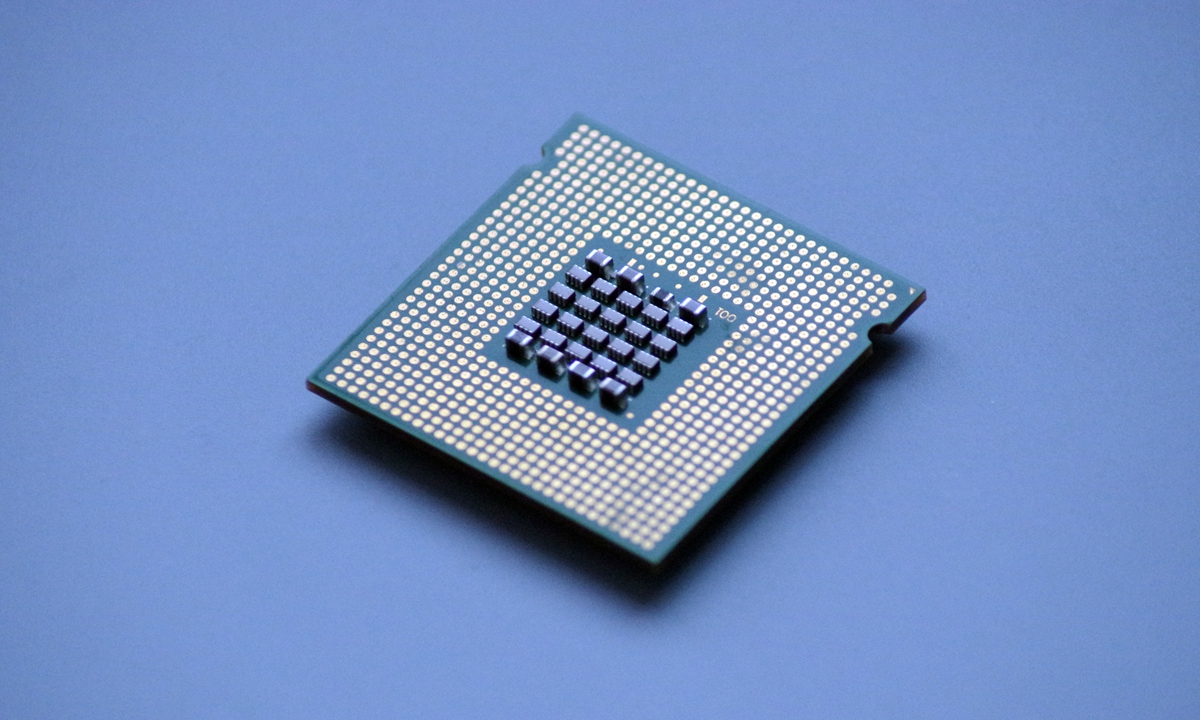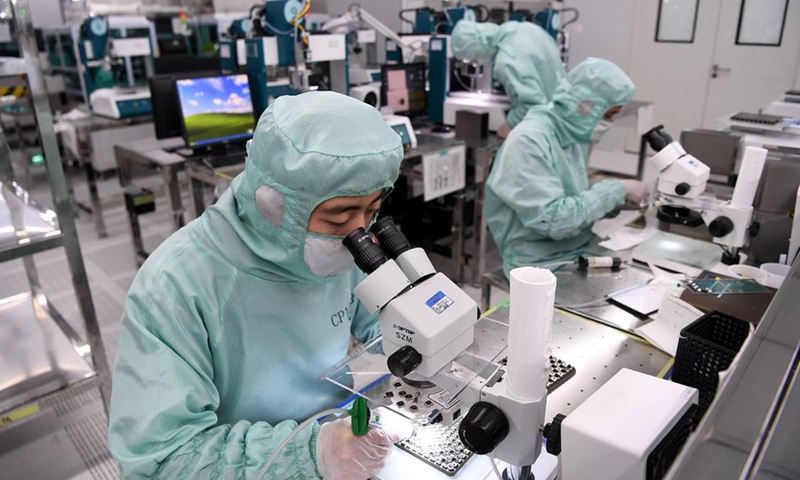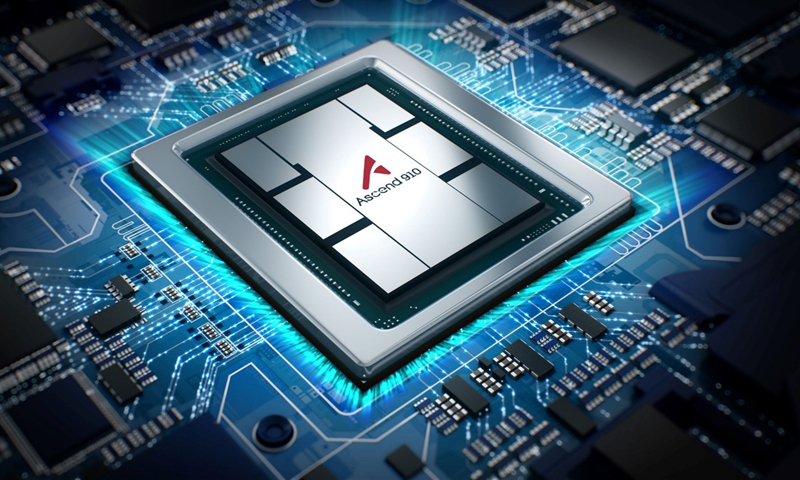Semiconductor as natl plan a ‘counterattack’ on US
By Li Xuanmin Source: Global Times Published: 2020/9/4 20:59:00 Last Updated: 2020/9/4 21:22:52
3rd-gen chips strategy to give China ‘upper hand’

Photo:VCG
The inclusion of the third-generation semiconductor industry into China's 14th Five-Year Plan (2021-25) - which led to an across-the-board rally in chip shares on Friday - is expected to give China an "upper hand" in the next battlefield of global chip technology, providing Beijing with more leverage to Washington's restrictions and malicious crackdown on Chinese tech firms.
The move underscores a top-down counterattack that China will wage, as a US chip ban that reduces wafer shipments to Huawei draws near, industry observers said.
They noted that China's broad support for next-generation semiconductor technology sends a warning to foreign chipmakers: If they don't supply Chinese companies, the country's homegrown chip "titanic," in the next few years, could kick them out of the Chinese market and possibly eat up their global market share.
China has added plans to bolster the development of the third-generation semiconductor industry into its 14th Five-Year Plan, a participant in the drafting of the plan confirmed to the Global Times on Friday.
The guidelines are scheduled to be finalized and released by the end of 2020, according to the participant, who spoke on condition of anonymity. The drafting started several years ago, and has since been revised many times.
Bloomberg reported on Thursday that the suite of measures to scale up industry support includes bolstering research, education and financing, but it did not go into details.

Technicians work at a workshop of a company in Nanchang, east China's Jiangxi Province, Feb. 14, 2020.Photo:Xinhua
The participant said the plan will be an industrial layout, including support for research and development (R&D) in terms of raw materials for the third-generation semiconductor industry, such as chemical compounds.
"Unlike the second-generation semiconductor technology, which China is now restricted in a wide range of areas, from raw materials to production equipment, the next generation of chip technology is a 'fresh start' and a good opportunity for China to gain an advantage over rival foreign competitors," he said.
In addition to raw materials, industry observers also expect more support measures to help speed up the R&D of homegrown lithography machines, a core equipment in chip manufacturing, whose technology has been dominated by the Netherlands-based ASML.
The plan marks the first time that Beijing, amid Washington's relentless crackdown on China's tech rise, has calibrated a systematic architecture on developing the next generation of chip technology, as it looks to elevate its strategic importance into one of China's most important economic and industrial strategies for the next five years.
In the past few years, different departments and ministries have mulled over sporadic preferential policies, such as tax breaks, financing, land leasing and employment, to support the semiconductor industry. China also set up a national fund of more than 200 billion yuan ($29.26 billion) last year to nurture the domestic chip industry.
Urgent tasks
"China did not plan to master every piece of chip technology at the start. But now, due to increasing aggression from the US on Chinese tech companies, authorities have formed a sense of urgency, and will spare no efforts to boost the homegrown chip industry," the source said.
Some industry observers also compared the importance of such a mission to lunar exploration, as chips are considered the foundation for any advanced technological breakthroughs.

The artificial intelligence processor Ascend 910 provided by a photo released from Huawei, August 23, 2019.File photo:Xinhua
Richard Yu Chengdong, chief executive of the company's consumer business group, said last month that its high-end Kirin series of chipsets will not be produced after September 16, and Huawei's Mate 40 smartphone series will become the last flagship product to carry those chips.
A ban on chip shipments to Huawei will take effect on September 15. So far, the Taiwan-based chip manufacturer, TSMC, and US memory chip maker Micron have confirmed they will stop supplying Huawei after the deadline.
Despite the ban, China's semiconductor-related shares opened higher on Friday, with some rising by the daily limit, reflecting strong market confidence on how the plan could effectively counter the Trump administration's scheme to cut Chinese firms from the chip supply chain.
Shares of Chinese chip designer Xiaocheng Tech rose 20 percent on Friday, while shares of Techsem climbed 16.28 percent.
"The government plan has injected a much-needed shot in the arm into the industry. The top-down design will hopefully coordinate every 'player' in a harmonious way to achieve maximum benefit, while also reducing the risk of making individual investments," Ma Jihua, a veteran industry analyst, told the Global Times on Friday.
More bargaining chips
In the next five years, the plan will address acute issues across the industrial chain so that China will have more "cards" on the negotiating table that could be used to retaliate against arbitrary US moves, analysts said.
"As China develops certain core chip technologies, it would be easier for it to fight back and find a balancing point that might see both sides becoming even," Ma said.
Looking at the long term, the anonymous source stressed that there will be a "consistency in industrial policy." Ma predicted the primary goal for the next two decades would be to advance the country's chip technology to a world-leading level.
In Shenzhen, South China's Guangdong Province, the tech powerhouse dubbed as China's Silicon Valley, local high-tech firms have been preparing for what they described as a three to five year "belt-tightening" period. From their perspective, however, such "blink darkness" will eventually lead them to the dawn.
"What can't be achieved with a nationwide effort and the sheer size of the market? We just need patience and time," an executive of a Shenzhen-based TV maker, who spoke on condition of anonymity, told the Global Times.
He used to source the bulk of their chips from US and South Korean suppliers, but has since shifted to domestic suppliers.
In early September, Huawei's rotating CEO Guo Ping vowed the company will continue investing in its chip arm Hisilicon despite the US ban. He stressed that Hisilicon will only grow stronger in the next few years.
Industry observers said the national plan, although not yet made available to the public, also represents a warning from the Chinese government to foreign chipmakers who may bow to pressure from the US.

Pedestrians walk past electronic screens of the New York Stock Exchange (NYSE) in New York, the United States, Sept. 3, 2020. U.S. stocks plunged on Thursday, as a steep sell-off in tech shares dragged down the market. Photo:Xinhua
On Friday, the upswing trend in China's market stands in stark contrast to the "freefall" of US stocks on Thursday, led by a slump in chipmaker shares.
Shares of Nvidia tumbled 9.3 percent, while Broadcom and Qualcomm dropped by 6.1 percent and 5.5 percent, respectively, as investors showed concern over an increasingly stronger Chinese chip industry that could possibly weaken the revenue of US semiconductor producers, some of which are heavily dependent on the Chinese market.
"If you cut supplies to Chinese tech firms, you're risking losing the Chinese market. The homegrown chip industry could actually kick you out of China in the next few years. And thanks to a scale effect, they could also take over your overseas share," Ma said.
The Chinese market accounts for 65 percent of Qualcomm's revenue. After cutting off supplies to Huawei, Micron is estimated to lose 10 percent of its revenue, or $2 billion, every year, media reported.
Newspaper headline: Semiconductor as national plan a ‘counterattack’ on US
Posted in: INDUSTRIES